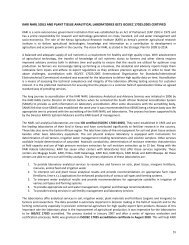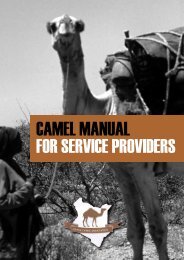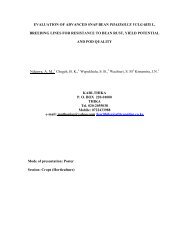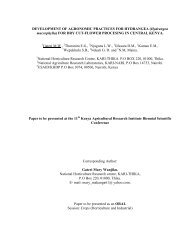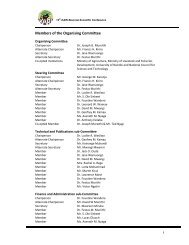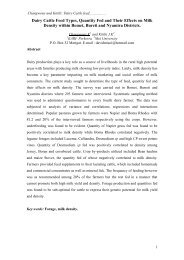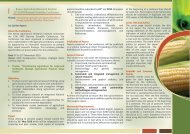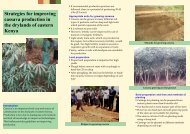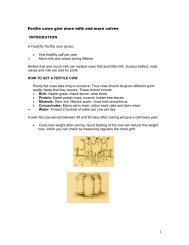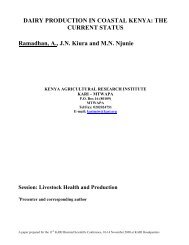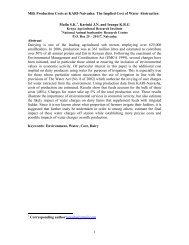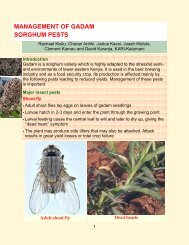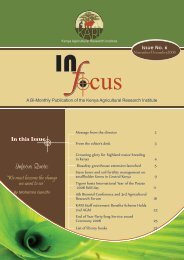January - June 2008 - Kenya Agricultural Research Institute
January - June 2008 - Kenya Agricultural Research Institute
January - June 2008 - Kenya Agricultural Research Institute
Create successful ePaper yourself
Turn your PDF publications into a flip-book with our unique Google optimized e-Paper software.
Case Study<br />
When Mr. Pius Makau retired as a security officer with<br />
Nairobi City Council in 2004 to settle on his 20 acre farm at<br />
Kyemole village, little did he know that his poultry<br />
enterprise would grow from 20 chickens to more than 400<br />
birds by <strong>2008</strong> to become a model farm for indigenous<br />
poultry production. He attributes his success to hard work,<br />
stick-to-it-iveness and support from his wife, Alice.<br />
Besides, the Makaus have a dairy herd of 6 cows<br />
comprising Friesian and Aryshire breeds, 15 zebu cattle<br />
which provide draught power, a flock of goats which act<br />
as a bank account for household needs and school fees,.<br />
They have 5 acres of horticultural crops, mainly mangoes<br />
and oranges, and 2 acres under apiculture. The farm is<br />
regularly visited by farmer groups from various parts of<br />
the country to learn skills on indigenous poultry farming.<br />
Mr. Makau has attended high profile workshops organized<br />
by KARI and University of Nairobi and is a member of the<br />
National Poultry farmer’s forum.<br />
The forum<br />
Dr. John Mugambi, Centre Director, KARI Muguga North,<br />
informed participants that KARI Animal health projects<br />
focus on working with stakeholders to control livestock<br />
diseases. Farmers participate fully in the research agenda<br />
by identifying constraints and opportunities for<br />
interventions so that ultimately they own the<br />
implementation process and are responsible for<br />
sustainability. He observed that we all grew up with<br />
chickens and therefore learned quite a lot about them. He<br />
said, it was important to take measures to improve rearing<br />
of chickens in order to increase survival rates and hence<br />
productivity and embrace poultry enterprise as a business.<br />
He added that KARI would soon be testing the<br />
thermostable Newcastle vaccine in farmers’ fields and<br />
therefore the cold chain which is a limiting factor in the<br />
delivery of the current vaccine would not be necessary.<br />
He distributed two extension leaflets produced by KARI<br />
to the participants: “Manual for indigenous poultry<br />
production No.18” and “Stop Newcastle”.<br />
Participants listed reasons for keeping poultry as<br />
providing income, protein nutrition –eggs and meat,<br />
business enterprise, provision of manure, gifts and social<br />
status. Constraints to poultry keeping were identified as<br />
diseases, poor housing, feeds, predators, lack of<br />
management skills, inferior breeds, marketing and lack of<br />
credit. Important diseases cited include: Newcastle, fowl<br />
pox, infectious bronchitis, coccidiosis and ecto parasites.<br />
On feeds and feeding participants shared experiences<br />
on making of home-made rations consisting of a mixture<br />
Participants keenly follow the session on good poultry<br />
housing<br />
Feeding chickens on home-made ration<br />
of maize bran, sorghum and green grams. Birds are fed in<br />
the morning on this ration and released to scavenge for<br />
the rest of the day. Participants learned how termites can<br />
used to provide a rich source of protein to poultry. The<br />
insects are easily harvested using a stack of moist grass<br />
placed around termite mounds for three days. Birds fed<br />
on this regime attain market weight of 2 to 3 kg within<br />
eight months while those on scavenging alone take twelve<br />
months.<br />
The farmers learnt that Newcastle disease which is a<br />
major cause of death among local chickens in the district<br />
can be controlled through planned vaccination. According<br />
to the veterinary office, the disease has a seasonal pattern<br />
and occurs in the months of July-August and <strong>January</strong>-<br />
February. Hence it is appropriate to vaccinate in the<br />
months of <strong>June</strong> and December . The Newcastle vaccine<br />
which is produced by Veterinary Vaccine Production Centre<br />
can be accessed by the local people through the Veterinary<br />
office in Wote or Agrovet stockists.<br />
Issues and recommendations<br />
Newcastle disease vaccine: Packaging, route of<br />
administration, cold chain and accessibility- Participants<br />
requested KARI to package the vaccine in smaller doses<br />
to enable farmers with few birds to access it. They felt<br />
that a vaccine administered through water would save on<br />
labor. Apparently VVPC produces the lasota strain<br />
Newcastle vaccine administered through drinking water<br />
but the farmers are not aware of its existence. The<br />
thermostable vaccine would be very attractive as it would<br />
not require cooling. It was suggested that a vaccine techno<br />
shop be set up at KARI Kiboko to enable farmers in<br />
Makueni and its environs including livestock keepers in<br />
Kajiado and other service providers easy access to KARI<br />
products. They welcomed KARI to use some of their<br />
farms in testing the thermostable vaccine.<br />
Market access: Marketing of chickens through a group<br />
was regarded as an alternative in the exploration of niche<br />
markets and accessing better returns.<br />
Record keeping: Participants agreed that record-keeping<br />
was a useful tool that assists in evaluating and determining<br />
profitability of farm enterprises.<br />
Biosecurity: Biosecurity issues are becoming key<br />
concerns in the poultry trade - footbath at farm entrance,<br />
separate housing for birds and human beings, prohibition<br />
of sale of sick birds and transportation of chickens in<br />
public service vehicles.<br />
Highlighter No. 23<br />
5



